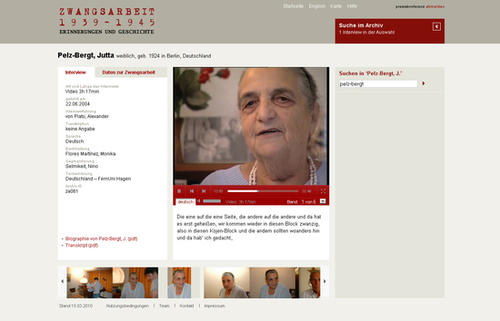History for the Head and the Heart
“Forced Labor, 1939–1945” project makes reports from contemporary witnesses available to schools and academics
Jun 25, 2010
"Forced Labor 1939-1945" is a digital archive for education and research.
Image Credit: Freie Universität Berlin / Center für Digitale Systeme (CeDiS)
When she was 18 years old, Jutta Pelz-Bergt was a slave laborer at Auschwitz, and in 1945, she survived one of the series of death marches from Auschwitz to Ravensbrück. With this past, the now 86-year-old Pelz-Bergt calls herself a “discontinued model,” with irony and a certain distance. After all, she was among the younger victims of the Nazi regime, and not many of them are still alive today. The Berlin-born Pelz-Bergt, who is Jewish, was among the more than twelve million people who worked as forced laborers and slaves for the German regime at that time. To preserve the memory of these events and support education in history and politics, researchers and faculty members from various disciplines at Freie Universität Berlin have developed an online archive entitled “Forced Labor, 1939–1945” for academic and educational use, along with digital materials designed specifically for use in elementary and secondary schools.
The digital archive was initiated through a cooperative project between the “Remembrance, Responsibility and Future” (Erinnerung, Verantwortung und Zukunft, EVZ) Foundation, Freie Universität Berlin, and the German Historical Museum. It is based on a collection of nearly 600 audio and video interviews with former forced laborers from 26 different countries. The collection includes four and a half hours of reporting from Jutta Pelz-Bergt on her life before, during, and after the Holocaust. She is modest in her assessment of the impact that her contribution, and the archive itself, will have on young people. “The reports may help a bit,” the elderly lady says, “in passing the history down to later generations.”
Miriam Mogge views the matter differently. The 19-year-old Mogge, who has just graduated from Berlin’s Sophie Scholl Secondary School, tested the learning software during the development process and got to know Pelz-Bergt personally along the way. While there is no substitute for personal encounters with people who survived the Holocaust, Mogge says, the interviews themselves are instrumental in giving history a face and removing it from the realm of anonymity: “The archive is about people; it’s not about facts and figures like in a history book. This way, you perceive new information not just with your head, but with your heart as well – and that makes a bigger impression.”
History teacher Bodo Förster has made the same observation: “The impact and authenticity with which the information is presented are impossible to achieve in normal instruction.” Förster, a tenured high school teacher, therefore sees a great need for instructional materials on the topic that include accounts from contemporary witnesses.
This need is precisely what the initiators of the “Forced Labor, 1939–1945” project aim to serve with the online archive, learning software, background films, and accompanying teacher’s guide, says Nicolas Apostolopoulos, head of the Center for Digital Systems at Freie Universität. The archive and the educational materials were developed at the center with support from the EVZ Foundation. Günter Saathoff, a member of the Board of Directors of the Foundation, which until 2007 was responsible for paying compensation to former forced laborers, highlights the importance of the project: “Our goal is not only to archive the memories, but also to make them accessible to people.”
There are plans to offer the teaching materials for elementary and secondary schools via the German Federal Agency for Civic Education in the future. The online archive is available on the Internet to registered users and has been used in teaching and research activities at Freie Universität since 2009.
Further Information
Freie Universität Berlin
Center for Digital Systems (CeDiS)
Public Relations
Katrin Plank-Sabha
Telefon: +49 (0)30 / 838 53705
Email: presse@cedis.fu-berlin.de

